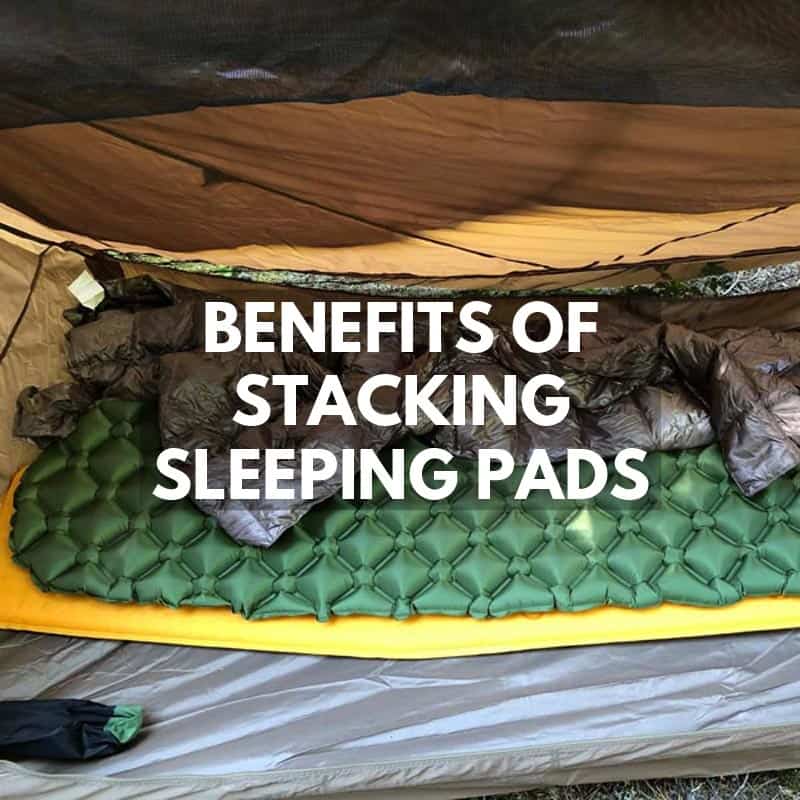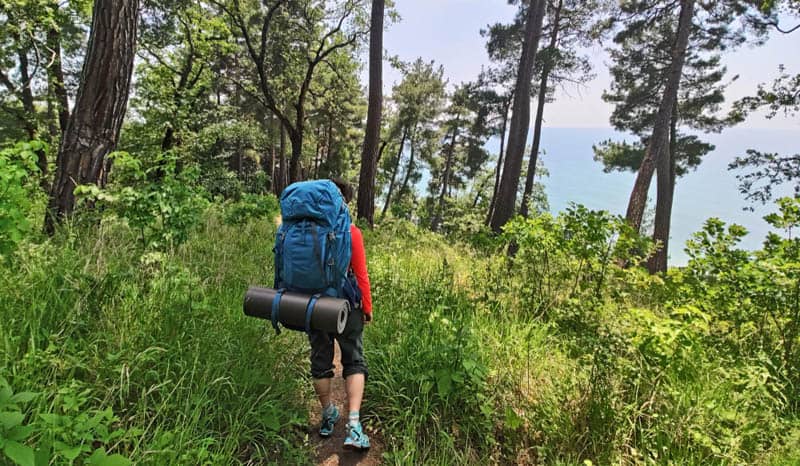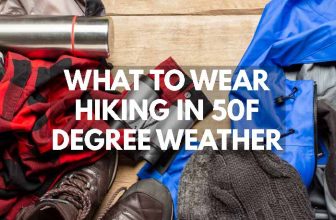Last Updated on 01/11/2022

In this guide to stacking sleeping pads on top of each other, we share our tips on doubling up on sleeping pads for warmth, comfort, and puncture protection. You will learn in which order you should stack your sleeping pads and why foam pads are the best companion to air pads.
If you are stacking a foam sleeping pad with an air mattress then there are two ways you can do it. If you want to protect your air mattress from punctures or muddy ground then a foam pad stacked underneath works best. If you want to improve warmth and comfort then stacking a foam pad on top of your air mattress will show the best results.
To really get into the weeds we will look at the different strategies for stacking sleeping pads and how they can achieve different results. For the most part, we recommend combining an inflatable sleeping pad with a foam camping mat but there are other things you can use instead. Check out this article about what to put under an inflatable sleeping pad If you want to learn about some other alternatives.
How To Stack Sleeping Pads for Warmth and Comfort
If you want to add warmth and comfort to your existing sleeping pad then adding a second one either underneath or on top can really help. The idea is to put your warmest sleeping pad on top of the other so that you retain the most heat from your body. To figure out which is warmest you may be able to look on the manufacturer’s website for an R-value or temperature rating.
Most foam sleeping pads have an R-value of between R1 and R2.2 which is ok for temperatures down to 20º F. Uninsulated air mattresses will typically have an R-value of between R1 and R1.5 but insulated air pads are the warmest of all with R-values up to 10+ and suitable for temperatures as low as 54º F. So, by stacking your warmest sleeping pad on top you will retain the most heat.
If you are sticking a foam sleeping pad on top of an air mattress when camping then you need to be extra vigilant about checking for puncture hazards before choosing where you put your sleeping pad. Never camp near a thorn bush for example.

How To Stack Sleeping Pads for Protection
If you are happy with your warmth and comfort but are worried about getting a puncture in your camping air bed then stacking a foam pad underneath is your best option. Foam pads are extremely durable and resistant to sharp rocks, small thorns, sticks, and other hazards which makes them the perfect liner.
You can also use other items to protect your sleeping pad but foam pads are the most ideal and stack very well. If you have two inflatable pads then the way to decide which to stack on top is to think about these three questions. Which is the most durable, which cost the most, and which is the biggest?
Ultimately the biggest sleeping pad should always go underneath but if you are worried about punctures then the most durable pad should go underneath. However, if I have a really expensive sleeping pad that is perhaps more durable than the second one then I would always protect my most valuable one by putting it at the top.
9 Benefits of Stacking Sleeping Pads
There are lots of benefits to stacking sleeping pads when camping and only a few downsides so let’s have a look at some of the reasons we think stacking sleeping pads is a good idea in cold or rough conditions:
1. Sleep Better
Ultimately, the only benefit that matters is that you sleep better. Think about it. If you stay warmer and more comfortable, you sleep better.
If you are not worried about puncturing your air mattress or soaking up ground moisture then you will fall asleep faster (in theory) and won’t be woken in the night to a deflated or wet sleeping pad. If you create distance between you and the ground to improve air circulation then you are less likely to suffer from tent condensation dripping on you while you sleep.
Most of the benefits of using a sleeping pad stacked on top of one another all come back to improving sleep length and sleep quality. Other benefits include allowing you to camp in winter or cold climates but again, so you can sleep better.
2. Stay Warmer
Stacking sleeping pads means a warmer night’s sleep for you. Adding a sleeping mat either underneath or on top of your regular sleeping pad will increase the thermal resistance between you and the ground. Improving your R-value rating and the temperature range your sleeping pad can be used in is easy when you stack sleeping pads.
To work out how cold your sleeping pad combination will go, simply add all the R-values together and use our sleeping pad rating chart.

3. Extra Comfort
If the ground is rocky, hard, lumpy, or uneven, a second sleeping pad can help to reduce any discomfort. By stacking an air pad on top of a foam pad or other durable mat, you can really sink into your sleeping pad without bruising your hips. If you only have a foam sleeping pad then adding a second will have a dramatic difference in your comfort.
4. Reduce the Risk of Puncture
By adding a foam pad or another durable layer underneath your air mattress you almost eliminate the risk of getting a puncture. One of the main concerns of campers using inflatable pads is that they might get a puncture while camping and have to spend the night without a pad. This is what put me off air pads for so long when I was younger.
5. Avoid Ground Moisture
When the ground is wet and muddy it never feels good to camp directly on the ground. If you don’t have a groundsheet you can use then a second camping mat can help keep the sleeping bag you are laying in dry and clean. If you have a tent with a bathtub floor then ground moisture is not of much concern.
6. Distance Yourself from The Cold Ground
When the temperature drops and the ground frost settles in for the night, the more thermal barriers you can stack underneath you the better. If you have an insulated sleeping pad designed for winter then you will still benefit from a thin foam pad underneath. If you are using two air mattresses stacked on top of each other then you could sandwich a mylar blanket between the two for a bit of extra thermal resistance.

7. Expand Your Sleeping Pad Season Rating
A benefit of using two or more sleeping pads stacked on top of one another is that with the combined insulation you can camp all year round, even when it snows. If your sleeping pad is rated for three seasons then adding a second sleeping pad will boost that up to a 4 season combination. Using multiple sleeping pads stacked on top of each other is better than having to buy three sleeping pads you can only use for a few months of the year.
8. Allows the Use of A Quilt
Camping with a quilt instead of a sleeping bag isn’t new but it does seem to be trending in recent years for lightweight hikers. The theory is that when you sleep in a sleeping bag the insulation underneath compresses so much that it becomes ineffective. So, you need a warm sleeping pad when it’s cold anyway, why not save some weight by using a quilt which keeps you almost as warm?
When you stack sleeping bags and improve your R-value using a quilt becomes a very viable option.
9. Use Bottom Sleeping Pad as a Sitting Mat
If you have an insulated camping pad and protect it with a foam pad or similar underneath that same pad can be used as a seat. Whether you are taking a lunch break or sitting around a campfire in the evening, a foam pad that you don’t mind getting dirty on one side always comes in handy. Even when it is still rolled up and fastened to your backpack you can use it as a seat without taking it off.

5 Disadvantages of Stacking Sleeping Pads
The benefits of stacking sleeping bags aren’t always clear until you try it out for yourself but the disadvantages are fairly obvious. The main problem is the fact that you have to carry a second pad which adds weight and bulk. Here are some of the reasons why you might not want to double up your sleeping pads:
1. Extra Weight
Sleeping pads can weigh anywhere from a few hundred grams to over a kilogram. Most foam camping pads weigh between 300 – 400 grams which isn’t too bad for the benefits they add when stacked with another sleeping pad. For the ultralight backpackers, you can get extremely thin EVA foam that provides some additional insulation and protection and hardly weighs a thing. Further down we have a tip for saving more weight.
2. Extra Bulk
The additional bulk is perhaps the biggest downside to carrying an extra sleeping pad. If the pad is foam you have to figure out a way to strap it to your backpack without getting in the way or falling off. No matter how you place it on your pack it is always going to stick out a little bit and rub against things in tight passages or walkways. You’ve just gotta deal with it.
3. Not Always Necessary
You may pack two sleeping pads thinking that you are going to have to stack them only to find that you don’t even need the second pad. This is annoying and not ideal but I can think of worse things! Even if stacking sleeping pads isn’t necessary when you find your campsite, you can still use them both for extra comfort and warmth – nothing wasted.
4. Can Reduce Stability
If you plan on stacking two inflatable air beds on top of each other and then always make sure the bottom air pad is fully inflated even if the top one isn’t. When both sleeping pads are partially deflated and you roll too close to the edge you are much more likely to roll off the edge than if just using one sleeping pad. To create the most stable stack of sleeping pads start with the largest at the bottom and make sure all but the top one are fully inflated.
5. Can Create Extra Noise
Stacking a sleeping pad on top of a sleeping pad can have an unforeseen downside that you might not have thought of. Sometimes the materials of two different types of mats can cause them to make rustling noises or even squeaks and rubbing noises with even the smallest movement. The most common description of this is when you roll over and your sleeping bag sounds like a packet of chips rustling around.

How to Pack Two Sleeping Pads in One Backpack
If you’re stacking two sleeping pads and one is inflatable while the other is foam then the best way to pack them is to pack your compressible air pad inside your bag and the foam pad strapped to the outside.
I like to put my compact sleeping pad next to my tent at the bottom of my rucksack because I only need to access them once a day whereas I may need to change clothes or get to my food and cooking apparatus multiple times.
My preference for a foam pad is to run it horizontally on the outside of my pack at the bottom or top using a bungee rope or some paracord. But I also don’t mind having it on the side of my pack horizontally and then balancing it out with a water bottle on the other side.
How to Double Stack Sleeping Pads Without Adding Too Much Weight
If you want to take advantage of the benefits that stacking sleeping pads has but don’t want to accept the extra weight there is something you can do with foam pads. You can lay on a foam pad and trace out your body into the shape of a mummy using a marker pen. Then carefully cut off the excess foam (like we did when making camp shoes here) so that you have the minimum amount of extra weight.
Another way to save weight is to use a 3/4 length sleeping pad on top and then a full-length pad underneath. This ensures that your torso and hips get the warmth and support they need from stacked pads but save you a quarter of the weight.
Thanks for reading our step-by-step guide to stacking sleeping pads when camping. We hope this helps settle some arguments and gives you a few ideas of how to camp in any weather during any season of the year.






